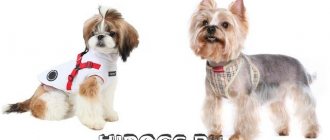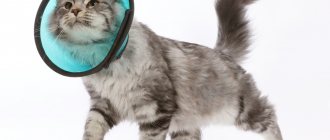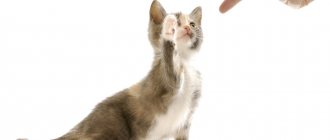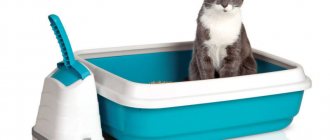General rules
You need to put a harness on your cat for the first time gradually, with preparation. If you initially scare or hurt the animal, then further communication with the equipment will be very difficult. Act like this.
- Introduce your furry friend to something new. Let me sniff, look and study. Proceed to put it on only after the cat accepts the item and is convinced that it is safe.
- Put on the harness according to the instructions, depending on its type. Adjust the size of the straps. Two of your fingers should fit between the structure and the animal’s body. This is a reserve of space for normal breathing. If the cat resists, then postpone the procedure for a while. Otherwise, the animal will think that the equipment is associated with discomfort.
- If you managed to put the harness on the cat, praise him and give him some kind of treat. Reinforce the positive experience in every possible way. Let the animal walk around the house a little in the new equipment.
- For your first walk in a harness, choose a quiet and peaceful place. A cat should explore the world with interest, and not be frightened by screaming children or dogs running past.
- If everything is done correctly and calmly, then next time it will be easy to pack the cat for a walk.
How to choose the right product
How to properly punish a dog for disobedience
A dog leash must be selected based on several different criteria. The first thing you should pay attention to is the size. A product that is too tight can lead to the development of various diseases or deformities of the paws. Too loose ammunition can cause the pet to break out.
Sizing
The wrong size makes it difficult to fasten the harness, it begins to move, and the chest strap ends up too close to the armpit. This situation causes severe discomfort. Over time, the dog will constantly struggle and twist, and will develop an abnormal gait.
There is a direct correlation between leash tugging and back problems.
Before heading to a specialty store, you need to take your dog's measurements. Measurements should be taken in this order:
- Neck circumference. The measurement is taken in the area where the collar is usually worn.
- Chest circumference. This indicator is determined behind the elbows in front of the paws, a little further from the armpits. If the dog is small, you need to add one centimeter. It will be easier for your pet to wear such a harness.
- Back length. It is measured from the withers to the base of the tail.
An important indicator is weight. Some products are not designed for the heavy load that will be exerted by large individuals. It should be taken into account that after purchasing a leash for a puppy, you will have to buy a new product in the near future, since the pet grows very quickly.
Material selection
The next selection criterion is the type of material used in manufacturing. The most commonly used material is canvas fabric, which is cheap but wears out quickly. If the structure gets wet quickly, it takes a long time to dry.
Another common choice is natural or artificial leather. Such material wears out quickly in extreme situations, so it is used for making exhibition harnesses. It is also worth considering that puppies love to chew on such material.
Nylon or nylon is considered to be a universal material. Basic properties:
- practically does not get wet;
- the surface is easy to clean at any time;
- nylon does not burst, does not become rough over time, and keeps its shape.
- The resulting seams are strong and tear very rarely.
The only serious disadvantage of artificial materials is that artificial materials cause an allergic reaction. Such a reaction occurs extremely rarely.
The harness is ideal for active animals and sledding breeds
Types of fasteners and belts
Another selection criterion is the number of fasteners and straps. A small animal requires a product with only a few straps. The relatively small load that is placed on the harness determines the use of plastic fasteners. They are inexpensive and durable.
Problems may arise when the product has only a few fasteners and the dog is heavy. They can be pressed into the fur.
For large dogs, you need to purchase a product with metal fasteners. The number of belts is selected depending on the task at hand. For a regular walk, only 3 harnesses are enough; for a sled dog, an option with 5-8 elements is required. They must run along the entire length of the body and are attached to the edges with special carabiners.
The design of the harness depends on the purpose
As the number of rings increases, the leash will hold stronger. If the pet often rushes forward, has a playful disposition and a large mass, then an option with three or more rings will be required.
Important! It is not recommended to take options with a large number of fasteners. This is due to the fact that the dressing procedure can take a long time.
Scheme of putting on different types
The simplest are considered to be figure-eight harnesses, which consist of two loops. When put on, they are fixed on the neck and torso, under the cat's front paws. There are varieties without a collar; they are more comfortable for animals.
However, the owners do not really like the latter option; it is more difficult to control the animal. Type H harnesses are similar to the previous ones, but there is a bar between the loops. Harnesses-vests are more expensive, but they also have more functionality. The equipment is similar to clothing and has comfortable fasteners. This is a great option for the off-season. This harness will protect your cat from dirt and cold.
Figure-of-eight harness
The design resembles intertwined straps that fasten to the body. The step-by-step instructions for putting on a harness and collar are as follows.
- Place the first loop around the cat's neck. Make sure that the ring for the leash is located on top, at the withers. If everything is correct, then the fasteners are on the bottom.
- Widen the large loop so that the paws fit through. The jumpers should be located on the chest, clearly in the middle.
- Thread the cat's paws one at a time into the loop formed.
- Fasten the strap under the paws or on the back.
- Attach the leash to the ring at the top.
The design, which is more convenient for the cat, does not have a collar. This option is presented in the form of 2 loops for paws. Put it on like this.
- Lay the harness on the floor or other surface.
- Place the cat's front paws into the triangles.
- Raise the belt and fasten it at the top of your back. Attach the leash carabiner.
Harness-vest
The models differ; the one-piece part can be located both on the stomach and on the back. The first ones are especially important to put on a kitten. Since such equipment resembles clothing, the donning scheme is similar. Usually there are no straps; Velcro and ties are used as fastenings. Wear a harness with fabric on the back like this.
- Place the whole part on your back. The fastening for the carabiner of the leash should be located clearly at the withers of the animal.
- Insert the paws into the different holes.
- You need to carefully fasten or tie, depending on the type of fastening, the ammunition on your neck and stomach.
- Make sure you don't fasten the harness too tightly. To do this, insert 2 fingers between the structure and the cat’s body; they should fit freely.
- Attach a leash or tape measure to the loop on your back.
Harness vests with fabric on the chest are less common. They are much easier to put on than the previous look. Take it step by step.
- Gently place the cloth on the cat's belly.
- Place the animal's front paws one by one into the corresponding holes.
- Connect the parts of the harness on the top of your back. Secure the ammunition with fasteners.
- Make sure the straps are not too tight. Otherwise, the animal will have difficulty breathing and may even experience pain.
- Attach the leash to the top ring.
Why do you need street ammunition?
Many owners of cats, especially those that are not bred, let their pets go for an independent walk in the yard. And outside the home, small predators face dozens of troubles in the form of yard cats guarding their own territory, aggressive dogs and cars. It’s not worth reminding once again about the possibility of infection with parasites (fleas, ticks, lice eaters). In addition, cats are freedom-loving creatures and it is often not so easy to return them home.
A pet on the street faces many other dangers from people. And a trip to the veterinarian or a trip will become a difficult mission if the cat does not want to sit in the carrier. But what to do if you can’t keep a curious freedom lover at home? There is an exit! You can walk your fluffy, controlling his freedom of movement. Fortunately, today the choice of accessories is quite wide.
Types of harnesses
At the moment there are several types of harnesses:
- eights;
- vests and overalls;
- Y-harnesses;
- V-shaped harnesses;
- H-type;
- models with two jumpers.
Harnesses can be of different types
Below are more details about each of the presented types.
Eights
The simplest harness design is the figure eight. It consists of two (or more) straps fastened together in one place. For this characteristic feature the ammunition got its name. This type is divided into 2 subtypes: classic (finished look) and prefabricated (customizable length).
Y-harnesses
A Y-harness is the same as a figure eight harness, only it has a jumper on the chest. The scheme is exactly the same as the previous version: two (or more) straps are fastened together in one place.
Vests and overalls
Vests and overalls are decorative options. They cost more than regular models. Sewn from cotton, linen, synthetics. The length of the fasteners on the neck and stomach is adjusted using special sliders, which are installed on the main strap with a plastic carabiner.
Note! The design is different. You can choose a model to suit your taste and color.
V-harnesses
The V-shaped type of ammunition is similar to a diamond (when unfolded). Here 2 rhombuses have a common base. The clasp is on the back. It can be made in the form of two carabiners made of plastic or metal or in the form of rings that need to be fastened together using a carabiner on the leash.
For your information! This is considered to be the simplest and most common model.
Here 2 rings are connected to each other by a jumper, which will be located on the back of the animal. It is made from nylon, tightly sewn together threads.
Models with two jumpers
The least common models are those that have 2 jumpers: one on the back, the other on the chest. As a rule, they are more expensive than other types of this type of ammunition (with the exception of vests and overall models).
Note! Models are sold with and without a leash. The cost of the product in the pet store also depends on this.
How does a harness with two jumpers work?
Model selection
You can choose a practical harness for a cat at any pet salon. Their selection is so large that choosing a model to suit your taste will not be difficult.
You will need the accessory if you:
- often travel with your pet;
- Do you prefer to walk your cat in parks or in the yard from time to time?
- participate in international exhibitions, festivals, tournaments;
- visit the veterinarian at the clinic.
Important! Any walk for a cat brings new emotions and excellent prevention of heart and vascular diseases, obesity and diabetes.
Modern manufacturers of harnesses have prepared a huge selection of colors and models with various design features:
- Figure-of-eight harness. The most common option, which consists of a pair of straps. They are connected to each other, forming a “figure eight”, which is why the device got its name. It is necessary to fix the harness only on the animal’s shoulder blades, and not on the neck. The model has an affordable price.
- H-type harness. The design consists of 2 collars for the back and neck, which are connected by a single belt on the back of the animal. Its main advantage is the reliable fixation of the body, which does not allow the animal to be injured or suddenly slip out. The V-shaped model has the same characteristics.
- Harnesses-overalls. These products belong to the highest price category, but they also have better parameters. Owners of miniature cats should think about buying overalls. For such pets, the risk of damaging their ribs with a sharp tug on the leash is quite high, so there must be ideal fixation of the body. In addition, overalls can warm your pet if you decide to let him outside in cool weather.
Advice! When choosing a harness, make sure that the attached leash does not overload the animal’s fragile neck.
Try to purchase a soft model that fits perfectly to the cat’s body. An important aspect when choosing such an accessory is its price:
- Budget series. Inexpensive but high-quality models include products from the Jungle brands, nylon products from Ferplast CHAMPION, nylon leashes from ZooExpress, Trixie.
- Middle price segment. You will find more advanced “functionality” of harnesses in the collections of the Hunter and Yami-Yami brands. Accessories will be able to relieve the animal’s neck, evenly distributing the load along the back. The models have chrome fittings and can be adjusted to the size of the animal thanks to plastic sliders.
- Expensive harnesses. The high price of an accessory may indicate either the quality of the material and the popularity of the brand, or additional elements in the finishing of the harness. Thus, products from the brands Before, Rogz and CoLLaR have stylish decorations on the leash, demonstrating the status of the cat owner. Products can be made of dense, non-rough material (suede, corduroy, velvet), have an unusual pattern, rhinestones and other “quirks” for wealthy owners of purebred cats.
Design
A harness is an interweaving of thin straps that should wrap around the pet’s body in the area of the shoulder blades. Depending on the manufacturer, you can find products with a clasp on:
- stomach;
- breast;
- neck;
- back.
The harness also has a special ring (mainly in the area of the shoulder blades), to which the leash is attached using a carabiner. The most difficult thing is to put a collar-strap on a cat, but getting out of it is no less difficult.
In order for the cat to feel comfortable not only on your lap, you should buy a comfortable harness and secure it correctly on the animal’s body. Together with a harness on a leash, the risk that your four-legged dog will be exposed to any of the following troubles is reduced:
- attacks by stray dogs;
- attempting to steal an animal;
- accident on a busy highway.
It is also important to pay attention to the design of the straps, which should be easy to unfasten and freely adjustable. Their optimal width is 1.5 cm. A regular harness consists of 2 rings when fastened, one of which is placed around the neck, and the other is used to thread the pet’s paws.
Peculiarities
A cat of any breed is quite sensitive to discomfort. Carefully select an accessory for walking, preferring harnesses made of high-quality material and with durable elements over collars and rough leashes. The main factors when choosing will be:
- Material. High-quality harnesses are mainly made from elastic nylon, nylon and cotton with a durable structure. A harness with water-repellent impregnation would be excellent. The material should be easy to wash off dirt and be wear-resistant. Do not buy artificial or natural leather harnesses for cats. They will put pressure on the cat’s body, rub and squeeze the chest, causing discomfort to the animal.
- Size. Choose a harness that fits properly. This is easy to check: 2 fingers must fit freely between the accessory and the animal’s back. If the gap is larger, the cat will break out of the harness.
- Leash. Some products are already sold with leashes, others suggest purchasing such an accessory. The optimal length of the leash is considered to be 2 m, and its most convenient design is the roulette model.
- Fastenings. Such elements should have a comfortable fastener and not cause discomfort to the pet during active movements.
In the cold season, it is best to buy a “overalls” model with insulation for your cat, and in a warm season, a regular harness-strap.
Step-by-step instructions: how to put a harness on a cat
Before putting equipment on an animal, you can and should practice on a non-living object: on a suitable toy, figurine, etc. Cats feel the uncertainty and inexperience of the owner and can become very nervous. This will cause the pet to break out, bite, and scratch. If you manage to put on the harness, then out of shock the pet will try to remove the unfamiliar object.
- You need to carefully pick up your pet.
- Then the harness is prepared so that it can be immediately picked up and put on the cat.
- You should sit on the floor or on the sofa.
- A harness is carefully placed on the animal's body.
- All actions are performed smoothly, without sudden movements and at the same time quickly.
- The ammunition straps are tied/snapped/fastened.
Note! After the process is completed, you need to put the animal on the floor and let it get used to the new object. When the kitten gets comfortable, you can attach a leash to the kitten’s kit and walk around the apartment with it. The animal can then be taken outside to a quiet place where there are few people and no cars or other stray animals.
All harnesses are constructed according to the same type
Examples with different types of harnesses
Instructions for use for the classic eight:
- You need to unfasten both straps.
- Then carefully pick up the cat and place it on your lap.
- Put on a harness. First, the strap around the neck is fastened.
- The metal ring to which the leash is attached must be placed strictly between the cat’s shoulder blades.
- After this, you need to fasten the strap, which is located in the torso area.
- At the very end, you need to fasten the leash to a special metal ring.
Step-by-step instructions for a prefabricated figure eight:
- The end of the adjustable strap must be passed through a small loop (bridle).
- Then a free loop is made.
- Carefully place the cat on your lap and place a loop around its neck.
- The length of the neck strap needs to be adjusted independently. It is important that it is not too loose or too tight.
- Then the remaining part of the strap needs to be wrapped around the pet’s body and fastened to the desired hole (adjustable in length).
- A leash is attached at the end.
Comparison with a collar
When choosing an accessory for a walk for their pet, many owners are guided by their own taste. Some prefer collars due to their ease of use and low price.
Harness with leash
However, there are a number of objective reasons why a harness is better than a collar:
- A relic of the past. Today, collars are more often used as an anti-flea product rather than for walking an animal.
- Discomfort. A high-quality harness will not cause discomfort to the cat, unlike a collar. If it is not properly fixed on the animal's neck, it can put pressure on it. This will cause your pet to feel pain, followed by panic, wheezing and shortness of breath. Any strain on the throat provokes back disease, headaches and poor health of the cat.
- Unloading the spine. With a quality H or V-shaped harness, the load will be transferred only to the chest. This feature is important for pets suffering from diseases of the joints and spine.
- Increased cat safety. A leash on a harness increases the safety of the animal. With sudden jerks, it is easier for the owner to hold the cat than with a collar. Also, if your pet gets into an emergency (ditch, hatch, ditch or pit), using a harness will make it easier to pull it out and save it.
Collar with a leash
Even with the cheapest harness, you will be able to control your animal's actions better than with a collar on a leash.
How to accustom a cat to a leash and harness
It is recommended to accustom your pet to equipment from an early age. It is easier for young individuals to adapt to something new. Do not make sudden movements or forcefully put on the harness. In this case, the cat will form the wrong attitude towards this attribute.
- The cat should be given the opportunity to familiarize itself with the new item. The pet needs to be convinced that this does not pose any threat.
- If an item has an unpleasant (or disgusting) smell, you should wash it and dry it so that the persistent aroma disappears. Then it will be easier for the animal to accept new ammunition. You can put a harness in the place where your furry couch potato usually sleeps.
- After the pet begins to calmly perceive the attribute, you can try putting it on. Everything is done in a calm environment, without sudden movements.
- When a cat tries to resist, you first need to calm her down, let her relax, and then try again.
- After several attempts, the animal should be comfortable with the harness. Your pet should walk around the apartment like this.
- Only after this can you attach a leash to the harness and leave your pet for a while. A positive attitude towards the next new subject should be formed.
- Then, when the cat begins to calmly perceive everything, you can begin work: first, you should try to follow him around the apartment, and then teach him to walk in the direction the owner is going.
- After these lessons, the animal can be taken outside. In order for the cat to feel normal, it is recommended to take the first walk in a park, a deserted place, away from areas where dogs are walked. Also, there should be no extraneous noise, rumble, cars or other external irritants on the site.
Important! If a furry couch potato is under one year old, has no vaccinations and is having a very hard time getting used to a new environment, walking is not recommended, as the pet may develop uncontrollable panic while being outside. Also, you should not take a recently operated cat or a cat that is in late stages of pregnancy, or elderly cats that have never been outside, outside.
Walking on a harness is preceded by a long training period.
Walking with an animal is a process that should bring pleasure to the owner and pupil, and not stress and panic attacks. To avoid negative consequences when training a cat to wear a harness, you need to do everything gradually. You cannot forcefully put on ammunition, otherwise a negative attitude will form towards the item.
How to put on a harness correctly - stages of training
After purchasing a harness/leash, you should begin gradually accustoming your pet to a new thing.
- Let the cat get to know the new accessory better: smell it, touch it with its paws, play. Knowing the difficult nature of cats, many owners advise starting to try on a new item for the first time only after a few days.
- When your pet gets used to the harness, you can try to put it on his body. The entire procedure should be performed calmly, with soft and gentle movements, so as not to scare your four-legged friend. Having carefully put on the accessory, you need to adjust its size so that it fits tightly enough around the cat’s body, but does not interfere with it. After fastening the lock and attaching the leash, you should leave the harness for a while.
- It is advisable to carry out the first fitting before feeding, then your pet will understand that the procedure will be followed by tasty food. Then you can play with it without removing the accessory. This is how you can gradually tame your furry friend to a new thing.
Types of leashes for cats
The system consists of a harness and a body structure. When deciding how to put a leash on a cat, you need to take into account the features of both components. The main types of harnesses are:
- "Eight". Made in the form of circles of different sizes with a leash mount in the middle. The smaller one is for the neck, the larger one is for the body, with a carabiner for putting on.
H-shaped. The harness consists of similar loops separated by a short strip. Carbines are present on both.
Vest (T-shirt). Clothes reaching to the waist are equipped with a carabiner for a leash. It is more difficult to get out of such a harness.
When thinking about how to put a leash on your cat, you first need to choose the type of system. There is no optimal option. Some owners prefer a figure eight harness, others prefer an H-shaped harness. It is believed that the first one is more difficult to get out of, but the result depends on the material, the fit of the harness, and the flexibility of the pet.
A vest is a promising option for an injured, sensitive animal. Wide stripes are less irritating to the skin. But contact with a larger surface can be unnerving. A cat that calmly perceives stripes of fabric will strive to get out of a vest, T-shirt, or medical bandage.
The choice of harness depends on the pet. A nervous, independent cat should be dressed in a harness with several carabiners. The animal may like the vest more than the stripe system. The soft, multi-layer structure, which resembles a simplified version of a backpack strap, is less chafing than the webbing that harnesses are often made from.
The leash is a separate issue. Roulette is suitable for dogs. If you decide to walk with cats, it is better to use a product of a fixed, short length. The pet must remain visible, not be able to climb into hard-to-reach places, or tangle the leash.
Do not attach the leash to the collar. Cats are more flexible and active than dogs - this design creates a risk of injury and death. A harness is not an alternative to protection during a car trip. The cat can be restrained, but the harness, including the vest, cannot be expected to prevent injury in a crash.
Harness sizes
Before you think about how to accustom your cat to a harness and leash, you should buy a suitable set. The harness is produced with markings:
You cannot rely on letter designations; you need to check the real parameters of the cat. To select a harness, measure the circumference just behind the front paws, adding 5-7 cm. The best option is to be able to stick 1-2 fingers under the slings. In addition to carabiners, designs often have buckles that regulate the length of the sling. In vests the function is limited.











